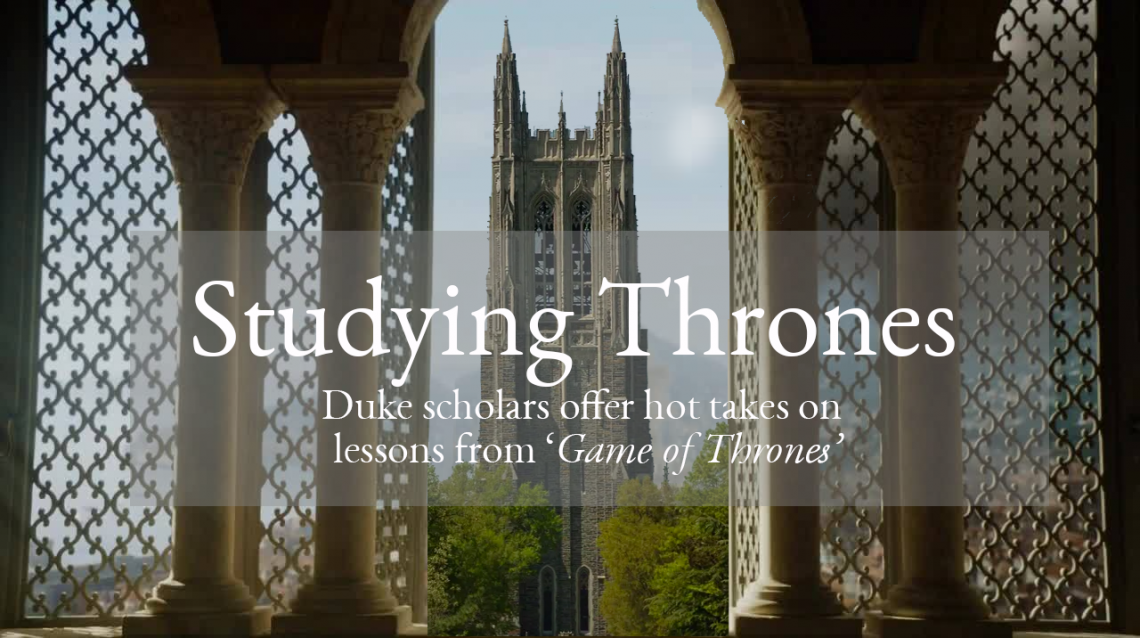The Genetics of Game of Thrones, or How Joffrey Became Such a Jerk
Mohamed Noor on what GOT can teach about the rules of genetic inheritance

 Week one of the final season of “Game of Thrones” is over. The White Walkers are on the move (slowly) and political stability in Westeros remains on edge. How did things get so challenging?
Week one of the final season of “Game of Thrones” is over. The White Walkers are on the move (slowly) and political stability in Westeros remains on edge. How did things get so challenging?
One part of that answer is genetics. The ruling elite of Westeros is rampant with inbreeding, (including incest in the ruling Targaryen and Lannister families), and -- much like that of medieval Europe – erratic and often violent royal behavior has followed.
Mohamed Noor, professor of biology and winner of the prestigious international Darwin-Wallace Medal for evolutionary studies, says “Game of Thrones” offers useful lessons for understanding rules of inheritance, recessive mutations, and the nuanced connection between genetics and behavior. This interview is based on a presentation made on the topic by Noor and Duke faculty colleague Eric Spana at the 2018 Dragon Con.
Q: GOT is fiction. But in real life, royal inbreeding has had historical effects for centuries. What are some of the examples that might suggest that a historian (or author) should be interested in royal genetics?
NOOR: Inbreeding leads to disease because most people carry one or more bad mutations at a few genes. If people marry non-relatives, these mutations tend to be "masked" by us having a second, non-mutant copy of all our genes (we get one copy from mom and one from dad). Even if both mom and dad have mutations, they probably don't have THE SAME mutations.
When people marry their relatives, it's way more likely the kids will inherit two copies of the same mutation, so there's nothing to mask its bad effect. In ancient Egypt, King Tutankhamen (Tut) was the son of a brother-sister pair, and the close relationship of his parents likely caused or worsened a suite of problems: cleft palate, scoliosis, and more. King Tut married his half-sister, and neither of their daughters survived infancy (one also having multiple visible abnormalities), again likely resulting from inbreeding and them carrying some of the same bad mutations.
In a hypothetical situation, siblings Jaime and Cercei each get four bad genes from each of their parents, for a total of eight mutations. But they only share of four of them, b, d, h and j. If we assume that 1/4 of all these mutations affect empathy in some way, then it's likely Jamie and Cersei each have one bad copy of the SAME gene affecting empathy: perhaps j. All is not lost for their kids, however. Each also receive one good copy of that gene. So there is only a 25 percent chance that they receive two broken copies of the gene. It seems as if Joffrey lost on those odds.
Q: So Joffrey. His parents are siblings. He is power crazed and prone to violence. What might lead you to conclude the two are connected?
NOOR: Some of our personality traits and behaviors have a genetic component. For example, a 2018 study in Translational Psychiatry mapped some genes potentially associated with empathy in humans. Imagine that Joffrey's grandfather, Tywin Lannister, had a bad mutation in one of his two copies of a gene affecting empathy. Tywin himself may exhibit normal behavior (debatable whether this is the case) since Tywin's other copy of the gene functions normally.
Tywin may well pass along the broken copy of an empathy gene to his kids, Cersei and Jamie Lannister. Again, they may exhibit normal behavior (again, debatable, especially for Cersei) because the copy they got from their mom functions normally.
However, if Cersei and Jamie have a kid with each other, there's a 25 percent chance that kid will get two broken copies of this gene affecting empathy. That kid might then exhibit a psychiatric disorder like an extreme lack of empathy. Sounds like Joffrey! I should note that this is all speculation, but it's a reasonable hypothesis.
Q: What about his brother and sister? Why might they be spared some of these same issues?
NOOR: As noted, there's only a 25 percent chance that a kid of Jamie and Cersei would get two broken copies of the gene in the scenario above. Two siblings (e.g., Tommen and Myrcella) could easily have at least one functional copy of the gene and behave normally.
Q: Spoiler Alert! Many, many viewers, and I mean many, have been rooting for Dany Targaryen and Jon Snow get together in end. Is there any genetic reason that we might be concerned about such an outcome?
NOOR: YES! Daenerys (I can't say Dany) is Jon Snow's aunt, so they, too, are likely to share on average 25 percent of their DNA. If both inherited some bad mutations, perhaps from King Aerys Targaryen II (the "Mad King"), it's possible those bad mutations would not be masked by normal copies of the resulting genes, and the offspring may have a genetic disorder.
Q: Beyond the genetics, do you have a favorite character you are rooting for to end on the throne? Any thoughts on it will turn out?
NOOR: I'm just hoping that Bronn gets his castle. Everything else is secondary!
Read More
This is the second in a series of short interviews with Duke scholars discussing the popular HBO series thorugh the perspective of their scholarship.
Week One: Robin Kirk on What Science Fiction Can Tell Us About the Cost of Power In Our Own World
Next Week: Tim Profeta on Collective Action in Game of Thrones, or Why It's So Hard to Come Together to Fight Climate Change
Bonus Reading: Professor Stefani Engelstein on Is Game of Thrones Racist?